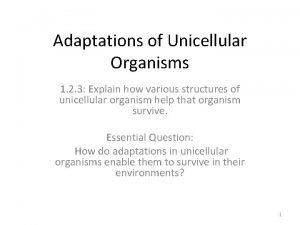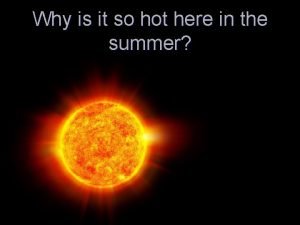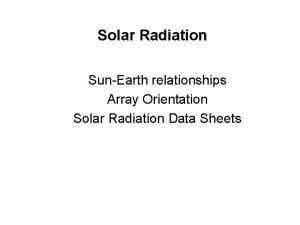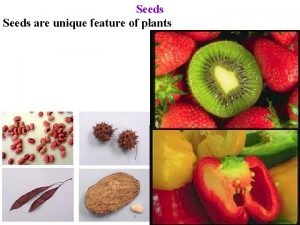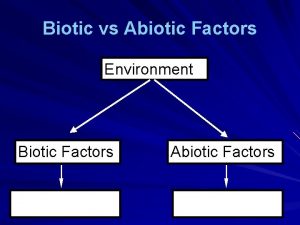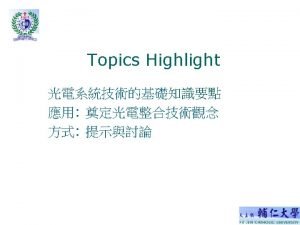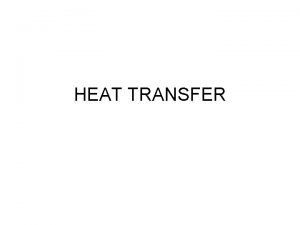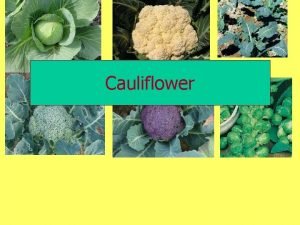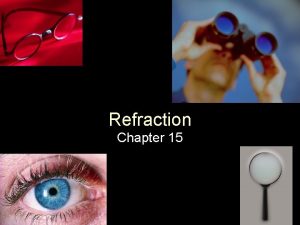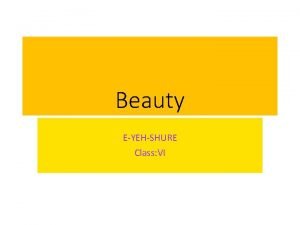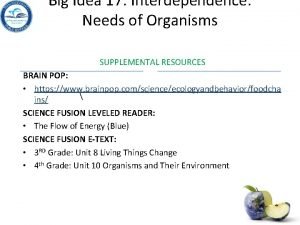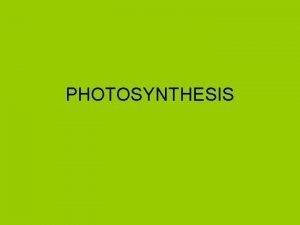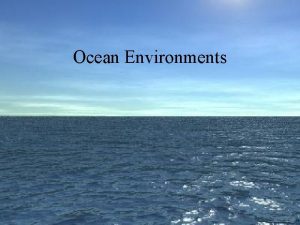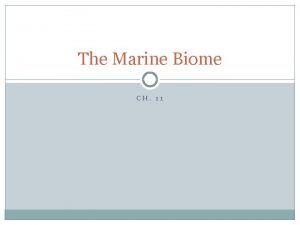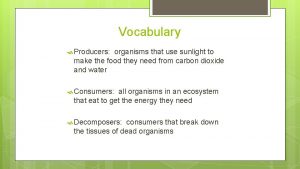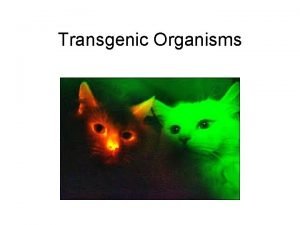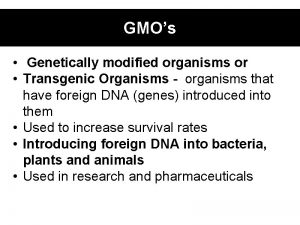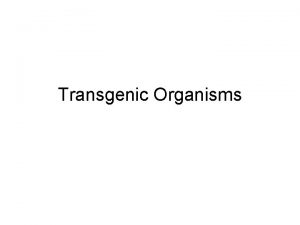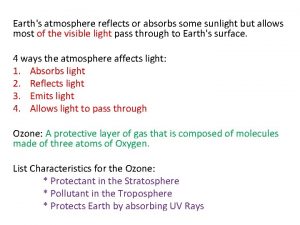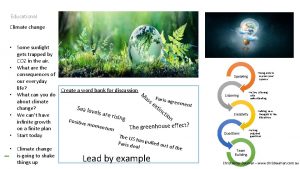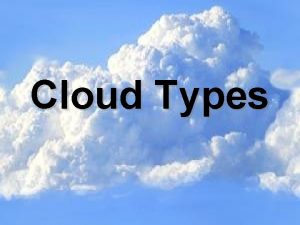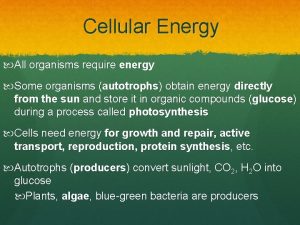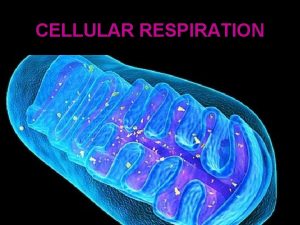Types of Organisms Some Organisms use sunlight to





















- Slides: 21

Types of Organisms Some Organisms use sunlight to make food in a process called photosynthesis: These organisms are called AUTOTROPHS or PRODUCERS. Some organisms cannot use sunlight to make food-they must eat instead: These organisms are called HETEROTROPHS or CONSUMERS.

Types of Organisms No matter how organisms get their food ALL get their energy FROM THE FOOD in the SAME way. Cellular Respiration

Cellular Respiration is a Process in which organisms create ATP from the food they make or eat.

Cellular Respiration During Cellular Respiration we take potential energy (stored energy) called chemical energy stored in the bonds of glucose and turn it into ATP is called free energy because it is available to do any type of work needed in our cells called Kinetic Energy (energy available for work) The amount of energy released is measure in calories or kilocalories The more energy a type of food can release the more calories it has

Cellular Respiration: catabolic, exergonic, aerobic process that uses energy to extract ATP (adenosine triphosphate) from an organic molecule called glucose Catabolic: breaks molecules down Exergonic: releases energy Aerobic: oxygen (O 2) requiring

Cellular Respiration is similar to breathing and respiration Breathing and respiration is an exchange of oxygen and carbon dioxide between blood and the outside air Cellular respiration is the exchange of oxygen and carbon dioxide between the cells and the blood

Cellular Respiration Makes up to 38 ATP Cellular Respiration uses the glucose we eat and the glucose plants make as well as the oxygen we breathe to create up to 38 ATP as well as the carbon dioxide we breathe out and water.

What is ATP? Adenosine Tri-Phospate: Made of three things 1. ) Ribose (sugar) 2. ) Adenosine (base) 3. ) Three phosphates Key to the activity of ATP is release energy as the bonds break between the phosphates

ATP ADP AMP ATP to ADP To ADP releases energy

Cellular Respiration takes place in three stages and in different places of the cell. Glycolysis: Cytoplasm (cytosol)Mitochondrial Krebs Cycle: Mitochondrial Matrix Electron Transport Chain: Inner Mitochondrial Membrane

Cellular Respiration: Mitochondria The mitochondria is designed to complete cellular respiration with maximum energy production. > There are many folds in the membrane to increase surface area and allows many reactions of Cellular Respiration to occur at once. This produces a lot of ATP.

Cellular Respiration is broken into three main parts. 1. ) Glycolysis: sugar splitting phase (glucose is the sugar) 2. ) Krebs Cycle (Citric Acid Cycle): Extracts the energy from glucose 3. ) Electron Transport Chain/ATP Synthase: Turns the energy into ATP for the body to use *In total makes from 34 to 38 ATP**

Stage 1: Glycolysis Location: Occurs in the cytoplasm just outside of mitochondria in two phases. A. Energy investment phase Put 2 ATP in to start the reaction B. Energy yielding phase Create 4 ATP MAIN GOAL: To split glucose

Glycolysis Process: Invest 2 ATP to start the reaction Split glucose molecule in half to create two molecules of Pyruvic Acid Produces two molecules of NADH from NAD+ Produces 4 new ATP molecules NET GAIN: 2 ATP (4 Produced - 2 Invested)

Glycolysis Reactants 2 ATP Molecules 1 Glucose Molecule 2 NAD+ Molecules 4 ADP Molecules Products 2 ADP Molecules 2 Pyruvate Molecules 2 NADH Molecules 4 ATP Molecules

Krebs Cycle (Citric Acid Cycle) Location: Mitochondrial Matrix Main Goal: Break down pyruvate to carbon dioxide and release more energy Process: Diffuse pyruvic acid into the matrix of the mitochondria Each pyruvate loses one carbon and makes a 2 carbon molecule called Acetyl Co. A The carbon join with the oxygen (aerobic) that breathe in to create the carbon dioxide we breathe out Acetyl Co. A now enters the mitochondria

Krebs Cycle (Citric Acid Cycle) Since there are two molecules of Pyruvic Acid entering the krebs cycle there must be two turns of the cycle. One for each pyruvate. 1. 2.

Krebs Cycle (Citric Acid Cycle) Reactants: Products from glycolysis Pyruvate to Acetyl Co. A ADP Oxygen FAD NAD+ Products: 4 Carbon Molecule to be recycled ATP Carbon Dioxide FADH 2 NADH

Electron Transport Chain Location: Inner Membranes of Mitochondria Main Goal: Use hydrogen ions and electrons to make up to 34 ATP Process: -All NADH and FADH 2 are electron carrier molecules - Made from glycolysis and krebs cycle NADH and FADH 2 donate electrons and hydrogen ions to make ATP

Electron Transport Chaine Reactants: ALL NADH and FADH 2 from glycolysis and the krebs cycle ADP Products: NAD+ and FAD ATP

Fermentation In some cases there is little to no oxygen present and organisms still need energy. Since cellular respiration is an aerobic process it cannot occur with out oxygen. -Fermentation occurs when no oxygen is present (anaerobic) -Two Types 1. Lactic Acid: Completes glycolysis and produces lactic acid 2. Alcoholic: Completes glycolysis and produces alcohol
 Competitive interaction
Competitive interaction Multicellular unicellular
Multicellular unicellular Unicellular organism
Unicellular organism Indirect vs direct sunlight
Indirect vs direct sunlight Solarsystem
Solarsystem Solar declination
Solar declination Seed maturation
Seed maturation Siklus hidup produk sunlight
Siklus hidup produk sunlight Biotic list
Biotic list Lux
Lux Sunlight melts a wax crayon left outside.
Sunlight melts a wax crayon left outside. Value added products of cauliflower
Value added products of cauliflower Raindrops sunlight and refraction lyrics
Raindrops sunlight and refraction lyrics E-yeh-shure beauty
E-yeh-shure beauty Plants getting sunlight
Plants getting sunlight Which object converts sunlight into sugars?
Which object converts sunlight into sugars? Ocean zones
Ocean zones How much sunlight does the marine biome get
How much sunlight does the marine biome get Is a car abiotic or biotic
Is a car abiotic or biotic They say sometimes you win some
They say sometimes you win some Sometimes you win some
Sometimes you win some Cake countable or uncountable
Cake countable or uncountable


